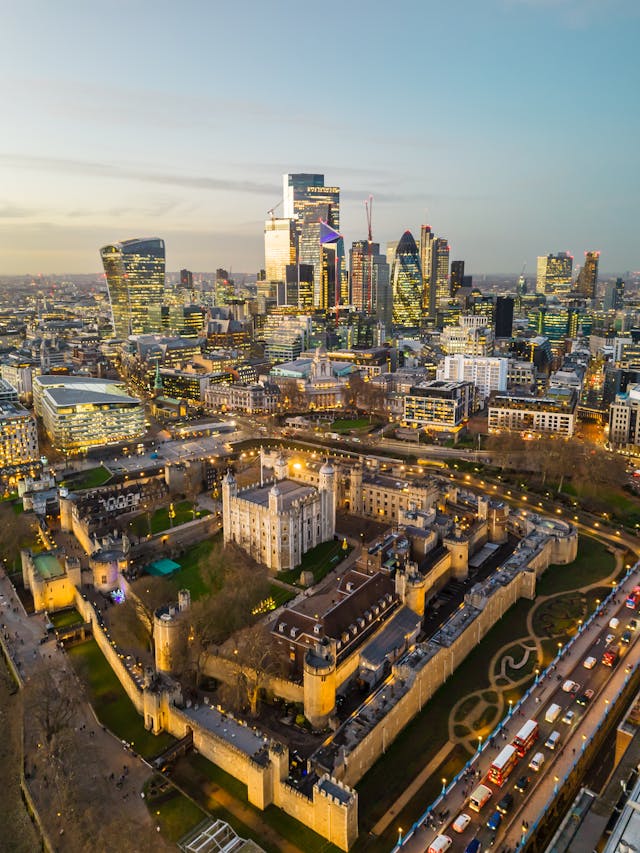The Tower of London
A Millennium of Power, Intrigue, and Royal Legacy
Standing majestically on the north bank of the River Thames, the Tower of London is an enduring symbol of British history, power, and resilience. This iconic fortress, with its imposing stone walls and distinctive turrets, has been a central player in the drama of English history for nearly a thousand years, witnessing coronations, imprisonments, executions, and the safeguarding of the nation’s most precious treasures.
Founded in 1066 by William the Conqueror, the Tower was originally built to subdue and intimidate the citizens of London following the Norman invasion. Over the centuries, it evolved from a simple wooden fortress into the complex stone citadel we see today. At its heart stands the White Tower, a masterpiece of Norman architecture and military engineering. This central keep, with its stark white limestone walls, has dominated London’s skyline for centuries and continues to captivate visitors with its formidable presence.
As you approach the Tower, you’re immediately struck by its commanding position along the Thames, with the more modern silhouette of Tower Bridge providing a dramatic backdrop. This juxtaposition of medieval fortress and Victorian engineering marvel offers a vivid illustration of London’s layered history.
One of the Tower’s most iconic sights is the Yeoman Warders, colloquially known as ‘Beefeaters’. Clad in their distinctive Tudor-style uniforms, these guardians of the Tower are more than just a tourist attraction. They are retired warrant officers from the British Armed Forces, each with at least 22 years of service. Their role combines ceremonial duties with sharing the Tower’s rich history, often through entertaining and sometimes gruesome tales of its past.
The Tower of London is perhaps best known today as the home of the Crown Jewels. This priceless collection of royal regalia, including the Imperial State Crown and the Sovereign’s Sceptre with Cross, represents the monarchical authority of the British Crown. The sight of these dazzling jewels, securely housed within the Jewel House, never fails to awe visitors.
As you explore the Tower complex, you’ll encounter numerous fascinating details that bring its history to life. Look out for the famous ravens, a group of at least six birds that have resided at the Tower for centuries. Legend has it that should the ravens ever leave, both the Tower and the kingdom will fall. The Ravenmaster, a Yeoman Warder, is specially appointed to care for these birds, ensuring this ancient superstition is never put to the test.
The Tower’s dark history as a prison and place of execution is evident in many of its features. The Traitors’ Gate, a water-gate entrance to the Tower, is where many prisoners, including Anne Boleyn and Sir Thomas More, entered the fortress by boat. In the Beauchamp Tower, you can still see graffiti carved into the walls by prisoners awaiting their fate. These poignant reminders of the Tower’s more sinister past provide a sobering contrast to its current role as a tourist attraction.
Throughout its history, the Tower has served various functions. It has been a royal residence, an armory, a menagerie, the home of the Royal Mint, and a public records office. Each of these roles has left its mark on the fortress, contributing to the rich tapestry of history that visitors can explore today.
The Tower’s strategic importance is underscored by its location. Situated at a bend in the River Thames, it was perfectly positioned to control river traffic into London. This location also made it an ideal starting point for the construction of Tower Bridge in the late 19th century, creating the iconic view we associate with this area of London today.
A visit to the Tower of London is a journey through the pivotal moments of English history. From the Norman Conquest to the Tudor period, from the Civil War to the World Wars, the Tower has played a crucial role in shaping the nation. Its walls have witnessed the triumphs and tragedies of monarchs, the scheming of courtiers, the suffering of prisoners, and the evolving story of Britain itself.
Today, as a UNESCO World Heritage site, the Tower of London continues to captivate millions of visitors each year. Whether you’re marveling at the Crown Jewels, listening to the tales of the Yeoman Warders, or simply soaking in the atmosphere of this ancient fortress, a visit to the Tower offers an unparalleled insight into the history, traditions, and enduring mystique of the British monarchy.
The Tower of London stands not just as a relic of the past, but as a living, breathing part of Britain’s national identity. It is a place where history comes alive, where ancient stones whisper secrets of power and intrigue, and where the pageantry and solemnity of royal tradition continue to thrive in the heart of modern London.

